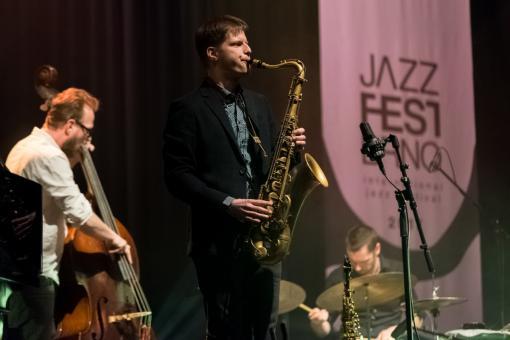The sixteenth JazzFestBrno – along with other strong programming – offers a chance to compare the playing of several excellent saxophonists. Immediately on the opening night (23 March) the exquisite Joe Lovano will be playing in the Sono Centre, and on 19 April in the same place Chris Potter will have his chance to shine as several times winner of various journalists’ surveys of the best players in the world on the tenor saxophone. Listeners will have a chance to compare two European players on Wednesday 29 March, when on the stage of the Sono Centre the Czech saxophonist based in Denmark, Luboš Soukup, and his Norwegian contemporary Marius Neset, also living in Copenhagen, take turns on stage. And on 5 April a young Czech who is studying in Norway, Michal Wróblewski, will be performing with his international ensemble.
But back to the double concert of Luboš Soukup and Marius Neset on 29 March. Both of these young players (Soukup and Neset were born in 1985) performed a selection of the best of their own works, in which the first went primarily for new items, while the second drew relatively more on older material. However of rather more interest was the comparison of their playing techniques, how they worked with rhythm and also the stage presentation of both musicians, among the best in their generation. A major contribution to the resulting positive impression from both concerts came from both of the accompanying trios (always with the traditional jazz line up of piano, bass and drums), which in the case of the Czech player was extended by the special guest, the Benin guitar virtuoso Lionel Loueke.
Loueke’s participation can be seen as wonderful seasoning and at the same time as a minor disappointment. If the listener was expecting a sound and rhythm exhibition such as that for example given on the African’s most recent album Gaïa, they might have been disappointed. However Loueke was fulfilling the task that had been assigned to him. He was an honorary guest, and not a soloist. So his playing was a sensitive accompaniment to his Czech colleague, chosen for the effects of interesting sound registers (often his guitar came across more like a keyboard instrument) and it added original colour to the accompaniment by the acoustic trio unlike anything that we have known so far from any of Soukup’s solo Czech discs. An element the significantly livened things up were Loueke’s vocals, which illuminated the opening work in the concert Země (Earth) immediately bringing to mind the comparison with the guitarist’s Gaïa, and in the closing encore. From this perspective the Czech-Benin cooperation which is to continue on Soukup’s next album is very promising. Those who were hoping to also hear something from Loueke’s own works, were given something to please them when after about an hour played Aziza Dance from the album Gaïa, which provided fans with a truly breath-taking exhibition of guitar playing (with a technique which was reminiscent of virtuoso bass playing), and of Loueke’s symbiosis with the whole group.
Luboš Soukup himself, who not long ago in Denmark got the title Discovery of the Year, quite often seemed to be copying Loueke. Even though at this point he was supposed to be the star, he did not push himself forward and rather served his own quality music. He swapped instruments (tenor and soprano) as well as tempos, and gave plenty of space for his fellow players, who he then joined, and managed to fit in with various registers of the playing of the pianist Christian Pabst. His compositions are structured, often moving from ballad-like passages to dramatic and less melodic sections (for example in Černý Žralok). Silence also plays an important role in his studied and brilliantly played compositions: in the sense of working with dynamics and also as true pauses between tones.
Marius Neset is a completely different type of player. If someone were to say that the Norwegian scene has not had such a good saxophonist since the incomparable Jan Garbarek it would not be far from the truth. If Soukup excels primarily through his artistry as a composer, Neset attracted attention from his first expressive work as a technically mature player. He also alternated the tenor and soprano saxophone, and he also understandably gave his players sufficient space, and that was even for extended solos of whole sections of a composition. However once he stood with his instrument at the microphone, there was no room for breaks. What’s more his compositions followed one after another and tenor and soprano were swapped so subtly that the listener had to be constantly on guard so as not to miss something. Neset’s concert, which gave the impression of one extended suite of fast and ballad-like passages, also offered a small excursion into the Scandinavian school of jazz. It was primarily in the work of the rhythm section and specifically the drummer Anton Eger that it was like hearing a distant echo of the today already legendary e.s.t. of the tragically deceased Esbjörn Svensson. This was on show not only in the sound of the acoustic drums, which at times sounded like electronic instruments, but also in the seemingly differing rhythms of the bass, drums and saxophone.
Just in the last year Marius Neset has released two significant album – one with the London Sinfonietta and one with the bass player Lars Danielssonn and the drummer Morten Lund – and on both he gives exceptional performances. In Brno he had no problem living up to this reputation.
Luboš Soukup Quartet feat. Lionel Loueke, Marius Neset Quartet, as part of the festival JAZZFESTBRNO. 29 March 2017, 7 p.m., Sono Centrum, Brno































